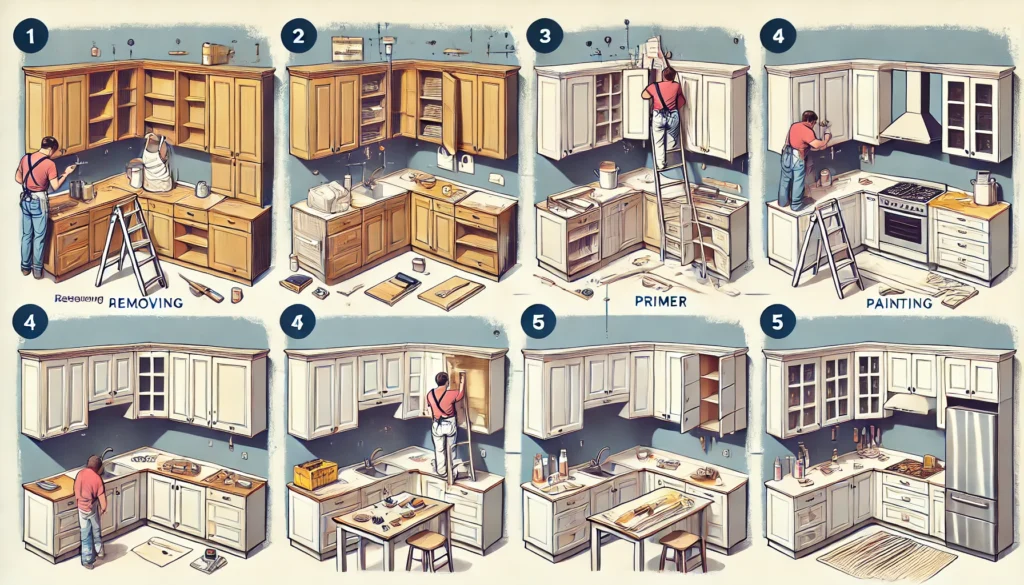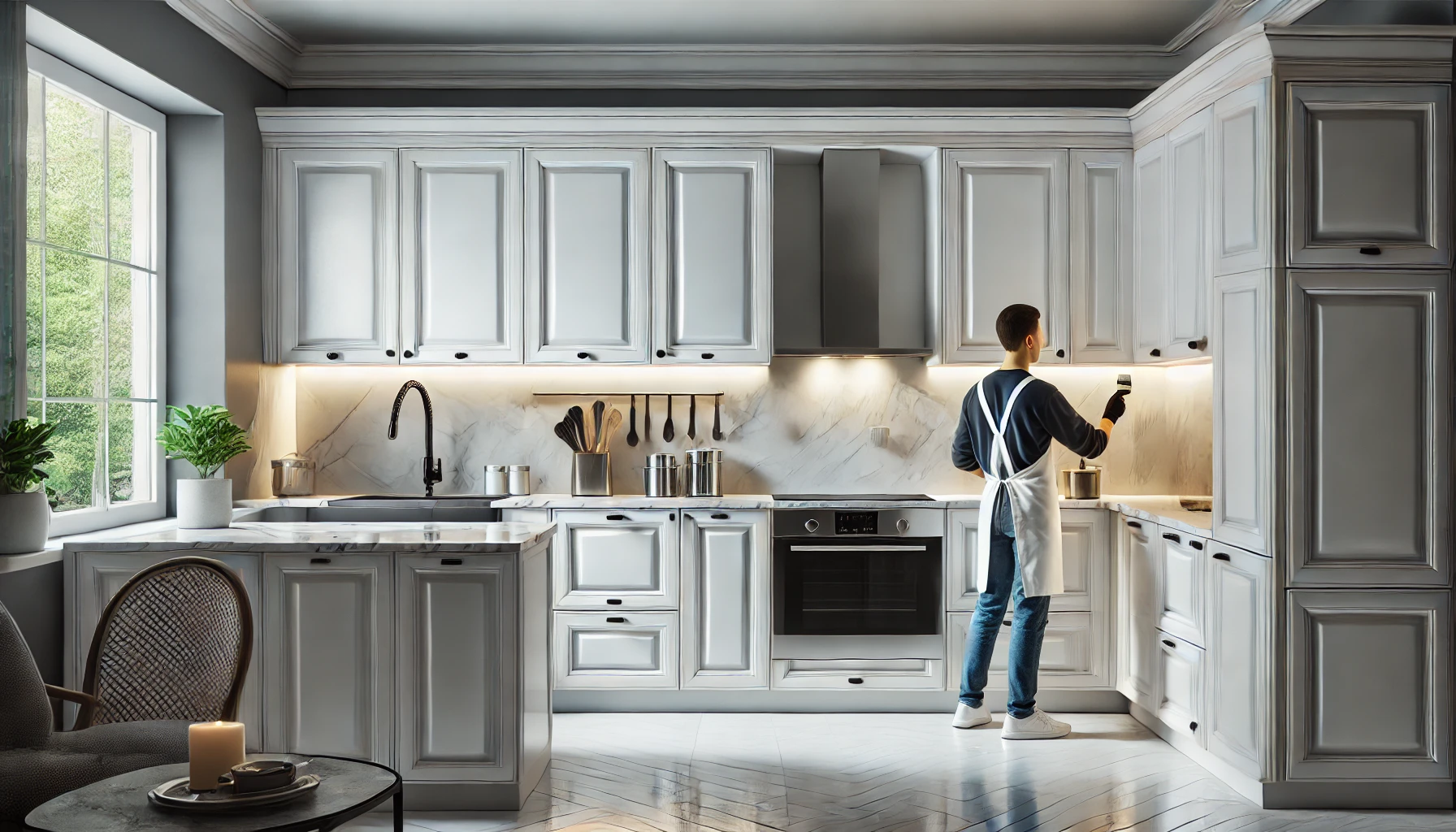A Step-by-Step Guide to Budgeting and Execution
Introduction
Repainting kitchen cabinets is one of the most cost-effective ways to refresh your kitchen’s look without undergoing a complete renovation. Over time, cabinets can become worn, scratched, or outdated in color. Instead of spending thousands of dollars on new cabinetry, repainting provides a budget-friendly alternative that delivers a fresh, modern aesthetic.
Cabinet repainting is not just about applying a new coat of paint—it involves careful planning, preparation, and execution to achieve a high-quality, durable finish. Whether you choose to do it yourself or hire professionals, understanding the costs involved is crucial. This guide will walk you through the entire process, from planning your budget to executing the job flawlessly.
Why Repainting Kitchen Cabinets is a Cost-Effective Choice
Many homeowners opt to repaint their cabinets instead of replacing them because of the significant cost savings. The price of brand-new kitchen cabinets can range from $5,000 to $15,000, depending on materials and installation costs. In contrast, repainting can cost anywhere from $500 to $3,000, depending on whether it’s a DIY project or a professional job.
Aside from the lower cost, repainting is also an eco-friendly option. Instead of disposing of old cabinets and contributing to landfill waste, refinishing them allows you to extend their lifespan while reducing environmental impact. Additionally, a fresh coat of paint can increase your home’s resale value, making it a smart investment for those looking to sell their property.
Another advantage is customization. With cabinet repainting, you have the freedom to choose any color and finish that best suits your style. Whether you prefer classic white, modern dark hues, or bold colors, repainting allows you to achieve the desired aesthetic without breaking the bank.
Factors Affecting the Cost of Cabinet Painting
Several factors influence the total cost of repainting kitchen cabinets. Understanding these elements can help you estimate your budget more accurately:
- Cabinet Size and Number – The more cabinets you have, the higher the cost of materials and labor. Larger kitchens will naturally require more paint and time.
- Paint Quality – High-quality paints, such as oil-based or specialty cabinet paints, tend to be more expensive but offer better durability.
- Surface Condition – If your cabinets require extensive repairs, sanding, or priming, this can increase labor costs.
- DIY vs. Professional Service – Doing the work yourself saves money on labor but requires more time and effort. Hiring a professional ensures a flawless finish but comes at a higher price.
- Painting Method – Spray painting provides a smooth, factory-like finish but requires additional equipment and setup compared to brush or roller application.
By understanding these factors, you can make informed decisions and plan your cabinet painting project effectively.
Understanding the Cost Breakdown
The cost of repainting kitchen cabinets varies widely based on the approach you take. Below is a detailed breakdown:
DIY vs. Professional Cabinet Painting Costs
DIY Cost: Repainting kitchen cabinets yourself can cost between $200 to $600, depending on the quality of paint and materials used. While this method is budget-friendly, it requires time, effort, and skill.
Professional Cost: Hiring a professional can cost between $1,200 to $7,000, depending on the size of the kitchen, complexity of the job, and location. Professionals ensure a high-quality, durable finish with specialized tools and techniques.
When deciding between DIY and professional painting, consider your experience level, time availability, and budget. While DIY saves money, professionals provide a more polished and long-lasting result.
Cost Per Square Foot vs. Total Cabinet Cost
Most painters charge based on either the square footage of the cabinets or a flat rate per cabinet door/drawer.
- Per Square Foot: The cost ranges from $3 to $10 per sq. ft.
- Per Cabinet Door: Expect to pay between $30 to $100 per door
- Total Kitchen Cost: On average, a standard kitchen costs between $1,200 to $4,500 to repaint.
The cost per square foot provides a more accurate estimate for those with irregular cabinet sizes. Meanwhile, a per-door charge is often used in professional pricing.
Paint Type and Quality Impact on Price
Choosing the right paint type can significantly impact your budget and results.
- Oil-Based Paints: These are durable and create a smooth finish but are more expensive and require longer drying times.
- Latex Paints: More affordable and easy to clean up but may not be as durable as oil-based options.
- Specialty Cabinet Paints: Designed specifically for cabinets, these are more expensive but provide a professional-grade finish.
Investing in high-quality paint ensures longevity and reduces the need for frequent touch-ups.
Labor Costs: What to Expect
If hiring a professional, labor costs typically range from $30 to $60 per hour. Some painters charge per cabinet, which can be between $75 to $150 per unit.
Labor costs cover:
- Prepping and sanding cabinets
- Applying primer and multiple coats of paint
- Drying time and reassembly
Understanding labor costs can help you negotiate better rates or decide if DIY is the better option.
Additional Materials and Tools
Apart from paint, other materials add to the total cost:
- Primer: $20 – $50 per gallon
- Brushes & Rollers: $10 – $50
- Sandpaper: $5 – $20
- Painter’s Tape & Drop Cloths: $15 – $40
- Protective Gear: $10 – $30
Purchasing high-quality tools ensures a smoother application and professional-looking results.
Step-by-Step Guide to Repainting Kitchen Cabinets

A well-executed cabinet repainting project follows a structured process. Each step plays a vital role in ensuring a smooth, professional-looking finish. Below, we break down the key steps involved in repainting kitchen cabinets.
Step 1: Planning & Budgeting
Before starting, it’s essential to evaluate the condition of your cabinets and set a realistic budget.
Assessing Your Cabinets: Can They Be Repainted?
Not all cabinets are ideal for repainting. Solid wood cabinets are the best candidates, as they hold paint well and can be sanded smoothly. Laminate or thermofoil cabinets can be repainted, but they require special primers and may not be as durable.
Check for the following:
- Surface Condition: If the cabinets have significant peeling, water damage, or warping, they may need repairs before painting.
- Existing Finish: Glossy finishes require extra sanding and priming to ensure the paint adheres properly.
- Hardware Condition: If your cabinet hardware is outdated, consider replacing it for a fully refreshed look.
If your cabinets are in poor condition, replacement might be a better option than painting.
Choosing the Right Paint and Finish
The type of paint and finish you choose will determine the durability and appearance of your cabinets.
- Best Paint Type: Acrylic latex or oil-based paints are the most durable choices.
- Finish Options:
- Matte: Low sheen, but harder to clean.
- Satin or Semi-Gloss: Easy to wipe clean, best for kitchens.
- High-Gloss: Reflective and smooth but shows imperfections easily.
Opt for high-quality cabinet-grade paints to ensure longevity and a smooth, professional look.
Calculating the Estimated Cost
To estimate costs, consider the following:
- Paint Cost: $30 – $70 per gallon (most kitchens require 2-3 gallons).
- Additional Materials: $100 – $300 for sandpaper, primer, brushes, and protective gear.
- Labor Costs (If Hiring a Pro): $1,200 – $7,000, depending on kitchen size.
A small DIY project may cost around $200 – $600, while a professional job can range between $1,200 – $4,500.
Step 2: Gathering Materials and Tools
Before starting, gather all necessary materials and tools to ensure a smooth workflow.
Paint Types: Oil-Based vs. Water-Based
- Oil-Based Paint:
- Extremely durable
- Smooth finish
- Long drying time
- Requires strong ventilation and mineral spirits for cleanup
- Water-Based (Latex) Paint:
- Dries quickly
- Easier cleanup with water
- Less durable but more environmentally friendly
If you want long-lasting results, oil-based paint is the best choice, but latex paint is more convenient for DIYers.
Primers, Brushes, and Sprayers
A high-quality primer ensures the paint adheres properly. Shellac-based or bonding primers work best for cabinets with glossy surfaces.
- Brushes & Rollers: Use a high-quality synthetic brush for smooth application. Foam rollers can help reduce brush strokes.
- Sprayers: For a professional, factory-like finish, consider using a paint sprayer, though it requires more prep work and ventilation.
Sandpaper and Cleaning Supplies
- Sandpaper (120 to 220-grit): For smoothing surfaces before priming.
- Degreaser or TSP Cleaner: Removes grease and buildup for better adhesion.
- Lint-Free Cloths: Wipe away dust after sanding.
Proper surface preparation is crucial for achieving a flawless paint job.
Safety Equipment and Protective Gear
- Gloves: Protect hands from chemicals and paint.
- Respirator Mask: Prevents inhaling fumes, especially for oil-based paints.
- Goggles: Shields eyes from dust and paint splatters.
Working in a well-ventilated area is essential, especially when using oil-based paints or strong cleaning agents.
Step 3: Prepping Your Cabinets for Painting
Preparation is key to achieving a smooth, long-lasting finish.
Removing Cabinet Doors and Hardware
Start by unscrewing cabinet doors, drawers, and hardware. Label each piece to ensure proper reassembly later.
Pro Tip: Store screws and hinges in labeled plastic bags to avoid confusion.
Cleaning and Degreasing the Surface
Use a degreaser or TSP (Trisodium Phosphate) cleaner to remove oil, dirt, and grime. This ensures the primer and paint adhere properly.
Step-by-Step Cleaning Guide:
- Mix TSP cleaner with warm water.
- Wipe down cabinet surfaces using a sponge or cloth.
- Rinse with clean water and let dry completely.
Sanding for a Smooth Finish
Lightly sand cabinets using 120- to 220-grit sandpaper to create a rough surface for the primer to stick to.
- For glossy surfaces, sand more thoroughly or use a deglosser.
- For raw wood, a finer sandpaper (220-grit) helps achieve a smooth finish.
After sanding, wipe away all dust with a damp cloth.
Applying Primer for Better Adhesion
Primer helps the paint stick better and prevents stains from bleeding through.
- Best Primers for Cabinets:
- Shellac-Based: Ideal for preventing stains.
- Oil-Based: Great for durability but takes longer to dry.
- Water-Based: Easier to work with but not as strong as oil-based.
Apply a thin, even coat using a brush or roller. Allow it to dry completely before proceeding.
Step 4: Painting Your Kitchen Cabinets
This step requires patience and technique to achieve a professional finish.
Choosing Between Brushing, Rolling, or Spraying
- Brushing: Best for detail work but may leave visible strokes.
- Rolling: Great for large surfaces but may require back-brushing for an even coat.
- Spraying: Provides the smoothest finish but requires proper setup and ventilation.
For best results, use a combination of brushing and rolling for cabinet doors and frames.
Applying the First Coat: Techniques and Tips
- Start with thin coats to prevent drips.
- Use long, even strokes.
- Let each coat dry completely before applying another.
Drying Time and Applying the Second Coat
- Latex Paint: 4-6 hours between coats.
- Oil-Based Paint: 16-24 hours between coats.
Two coats are typically recommended for full coverage.
How to Avoid Brush Marks and Drips
- Use high-quality brushes and rollers.
- Lightly sand between coats for a smooth finish.
- Apply thin coats rather than thick layers.
Step 5: Reassembly and Finishing Touches
Once the paint has fully dried, it’s time to put everything back together.
Reinstalling Cabinet Doors and Hardware
Reattach doors, drawers, and handles carefully. Ensure everything is aligned properly.
Adding a Protective Topcoat (Optional)
For added durability, apply a clear polyurethane or acrylic topcoat.
- Matte Finish: Subtle and modern.
- Glossy Finish: Enhances durability and shine.
A topcoat extends the lifespan of your painted cabinets and makes them easier to clean.
Cleaning Up and Final Inspection
Dispose of used materials properly, clean brushes, and remove protective coverings. Inspect cabinets for any missed spots or touch-ups.
Read More: how to paint kitchen cabinets professionally
DIY vs. Hiring a Professional: What’s Best for You?
Choosing between a DIY approach and hiring a professional painter depends on several factors, including skill level, time availability, and budget. Each option has its advantages and drawbacks.
Pros and Cons of DIY Cabinet Painting
Pros:
- Cost Savings: DIY painting can cost between $200 – $600, while professional services range from $1,200 – $7,000.
- Creative Control: You can choose colors, finishes, and techniques without restrictions.
- Personal Satisfaction: Completing the project yourself can be rewarding and fulfilling.
Cons:
- Time-Consuming: Prepping, painting, and drying can take a week or more.
- Skill Requirement: Achieving a smooth, professional finish requires practice.
- Mistakes Can Be Costly: Errors like brush marks, drips, or uneven coats may require repainting.
If you’re confident in your DIY skills and have the necessary time, painting cabinets yourself can be a great option.
How to Choose a Professional Painter
If you prefer professional results, hiring an experienced painter is the best route. Here’s how to find the right one:
- Check Reviews and References – Look at online reviews on Google, Yelp, and Facebook.
- Verify Licensing and Insurance – Ensure the painter is licensed and insured for liability protection.
- Request Multiple Quotes – Get at least three quotes to compare prices and services.
- Ask for a Portfolio – Reviewing past projects helps assess their quality.
A professional painter ensures high-quality results, but at a higher cost.
Read More: how to paint kitchen cabinets without sanding
Average Cost of Hiring a Pro
Professional painting costs depend on:
- Kitchen Size: A small kitchen may cost $1,200 – $3,000, while larger kitchens can reach $4,500 – $7,000.
- Paint and Materials: High-quality paints and topcoats increase the cost.
- Labor Costs: Expect to pay $30 – $60 per hour for labor.
If your budget allows, hiring a professional can save time and effort while delivering a polished, long-lasting finish.
Hidden Costs and Money-Saving Tips
Even with careful budgeting, unexpected costs can arise. Here’s what to watch for and how to save money.
Common Unexpected Costs
- Repairs & Patching – Fixing cracks, dents, or warped wood can add $100 – $500.
- New Hardware – Replacing outdated knobs and hinges can cost $50 – $300.
- Extra Paint & Supplies – Some cabinets may require additional coats, increasing costs.
Factoring in these hidden costs helps avoid surprises during the project.
Best Time of Year to Repaint for Cost Savings
The best times to schedule painting projects for lower costs are:
- Winter (Off-Peak Season) – Painters offer discounts as demand is lower.
- Late Summer or Early Fall – Dry, mild weather ensures quicker drying times.
Hiring professionals during slower months can result in better deals.
Tips to Extend the Life of Your Newly Painted Cabinets
- Use a Topcoat – A clear protective finish prevents chips and stains.
- Clean Regularly – Wipe with a damp cloth and avoid harsh chemicals.
- Avoid Excess Moisture – Water exposure can cause paint to peel.
- Install Soft-Close Hinges – Reduces impact and prevents wear.
With proper maintenance, a high-quality paint job can last 5 – 10 years before needing a touch-up.
FAQs – Common Questions About Cabinet Repainting Costs
How Long Does It Take to Paint Kitchen Cabinets?
The timeline varies based on drying times and preparation work:
- DIY Project: 5 – 7 days (including prep, priming, painting, and curing).
- Professional Job: 3 – 5 days, depending on the kitchen size.
Patience is key to achieving a durable, high-quality finish.
What Is the Cheapest Way to Repaint Cabinets?
- Use Budget-Friendly Paint – Opt for latex-based paints, which cost less than oil-based options.
- Skip Professional Services – Doing it yourself saves labor costs.
- Reuse Existing Hardware – Keeping the same handles and hinges reduces expenses.
For a budget project, expect to spend $200 – $400 on essential materials.
How Many Coats of Paint Are Needed?
For best results:
- 2 Coats of Primer – Ensures proper adhesion.
- 2 Coats of Paint – Provides full coverage.
- 1 Optional Topcoat – Adds extra durability.
Skipping primer or applying only one coat of paint can result in uneven coverage and a shorter lifespan.
Is It Worth Repainting Cabinets Instead of Replacing Them?
Repainting is a cost-effective alternative to full replacement:
- Cost Comparison:
- Painting: $200 – $7,000
- Refacing Cabinets: $3,000 – $9,000
- Replacing Cabinets: $5,000 – $25,000+
If your cabinets are in good structural condition, repainting is a smart investment.
Conclusion About how much to repaint kitchen cabinets
Final Thoughts on Cabinet Painting Costs
Repainting kitchen cabinets is a budget-friendly way to refresh your kitchen. Whether you DIY or hire a professional, understanding cost factors, preparation steps, and paint choices ensures a smooth process.
Is It the Right Choice for Your Budget?
If you’re looking for an affordable, impactful home improvement, painting cabinets is a great option. With proper planning and execution, you can achieve stunning results without breaking the bank.

